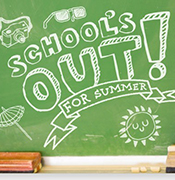
It’s official – summer is rapidly approaching! How do I know this? Well, until recently it certainly wasn’t because of the weather. I can tell summer is coming by the anxiety I see in teachers’ eyes as they consider the plans their students have, or do not have, for the summer. They share their concerns that many of these youth, especially their at-risk youth, will fall through the gap during these months. They worry about the potential for summer learning loss and general disconnection, of their students not utilizing this free time in a way that furthers their development in any positive fashion.
For most students, that first couple of weeks of summer are great – no obligation, no worries, no getting up early – but as the days go by, that time can easily become an avenue for making poor decisions, and this often ends up being the case – especially with older students.
It’s a universal problem: finding outlets that are both fun and interesting, or don’t cost an arm and a leg for parents, or are accessible if transportation is an issue. Even harder is finding something that encourages a new avenue of interest or provides a sense of purpose.
As Mark Zuckerberg recently put it in his commencement speech to the 2017 Harvard graduates, “Purpose is that sense that we are part of something bigger than ourselves, that we are needed, that we have something better ahead to work for. Purpose is what creates true happiness.”
Teachers can struggle with providing summer resources and generally their focus is centered on reading lists and activities happening at local libraries. I thought I would pull together some other resource lists and options, in no particular order, which may be beneficial to pass along to your students and families. I have come up with a very broad range of choices: from day camps to multi-week camps, camps tailored to special-needs kids to camps for foster kids, community-focused options to service projects, the arts and culture perspective to government-based opportunities – and everything in between. I hope this variety will help ease those frustrations of not having enough options for students and their families to take advantage of over the summer months.
- The Municipal Research and Services Center (MRSC) is a nonprofit organization. Among other things, itprovides some excellent resources for at-risk youth. “There appears to be no general definition of youth at risk, though there is a definition for at-risk youth inRCW 13.32A.030, as it relates to juvenile courts and juvenile offenders. A report done for the Health and Human Services Administration for Children and Families on resources for serving at-risk youth, uses the term at-risk youth to refer to young people for whom the probability of successfully transitioning to adulthood and achieving economic self-sufficiency is low.”[1]
- “4‑H is delivered by Cooperative Extension—a community of more than 100 public universities across the nation that provides experiences where young people learn by doing. Kids complete hands-on projects in areas like health, science,agricultureand citizenship, in a positive environment where they receive guidance from adultmentors and are encouraged to take on proactive leadership roles. Kids experience 4‑H in every county and parish in the country—through in-school and after-school programs, school and community clubs and 4‑H camps.”[2]
- Camp Ten Trees: Residential camping programs for LGBTQ youth and youth of LGBTQ families. “Camp Ten Trees is a place for diverse youth who share common experiences to come together and form a community that is truly their own. In addition to traditional camp activities like swimming, archery, and nature hikes, campers engage in age-appropriate workshops exploring identity,issues of oppression/privilege,youth coalition building, social justice, and more.”[3]
- Game Experience: The Game Experience is a comprehensive, integrated and all-inclusive game camp designed for today’s students.
- Seattle Aquarium Summer Camps
- UW Medicine Summer Teen Program “The Summer TeenProgram is available during the months of June through Augustfor teenagers aged sixteen through eighteen (who have not yet graduated from high school). Teenagersbuild leadership, teamwork and customer serviceskills and gain valuable exposure to the environment of healthcare ina nationally recognized medical center.
Summer Teens greet and direct visitors, transport patients, deliver specimens to the lab and flowers andmailto patients, support the Information Desk, and assiststaff with special projects. Due to the critical healthcare environment at UWMC, candidates for this program must be mature, reliable, self-directed, motivated, and able to work independently. They must also demonstrate excellent customer service and communication skills and be comfortable working with a diverse population.”[4]
- Teens in Public Service “connects teenagers with paid summer internship opportunities at local nonprofits. Since 1997, we have worked with nearly a thousand interns, over 150 nonprofits and altogether we have invested well over a 200,000 hours into the community. Teens In Public Service (TIPS) is dedicated to producing future leaders committed to their communities by connecting teens with life-changing opportunities and internships at nonprofit organizations.”[5]
- REEL GRRLS “empowers young women and gender non-conforming youth from diverse communities to realize their power, talent and influence through media production.”[6]
- Teen Filmmakers Program – Summer Teen Programs 2017: “The Summer Teen Filmmaking Programconcentrates on developing skills in video production. This intensivetwo week programculminates with studentscompleting a final projecton video. The program provides a practical foundation for filmmaking skills–lighting, camera, composition, and editing. Students take full responsibility for their projects as theywrite the scripts, prepare storyboards, and finallyshoot the project. At the end of the session, each student willtake home a DVD copyof the final projects completed during the class.”[7]
- School’s Out Washington: “Washington State is rich in STEM-focused industry, yet too few students are graduating with the skills and knowledge needed to enter STEM careers, especially girls, low-income youth, and youth of color. If these youth can’t see themselves in STEM careers, they are unlikely to chase their passions and pursue a STEM career. Afterschool and summer are the perfect places to engage youth in hands-on ways, from coding a satellite on the International Space Station to participating in a field ecology program in one of Washington’s many beautiful parks. By engaging students in STEM outside of the classroom, students can spark lifelong passions – by ensuring that STEM opportunities are available to those who need them most, we can diversify our workforce and our communities. STEM education doesn’t just teach students about science, technology, engineering, and math – students are also developing critical problem solving and thinking skills that can be applied to writing an essay or engaging with the world around them.”[8]
- 20 Summer Camps Around Seattle for Kids with Special Needs: Where kids with special needs, from physical or medical challenges to autism, can have an unforgettable camp experience.
- TreeHouse: Giving Foster Kids a Childhood and a Future: “In 2012, we embarked on a bold and ambitious goal to address the alarmingly high dropout rate among youth in foster care. We know that with intentional, individualized support, youth in foster care


